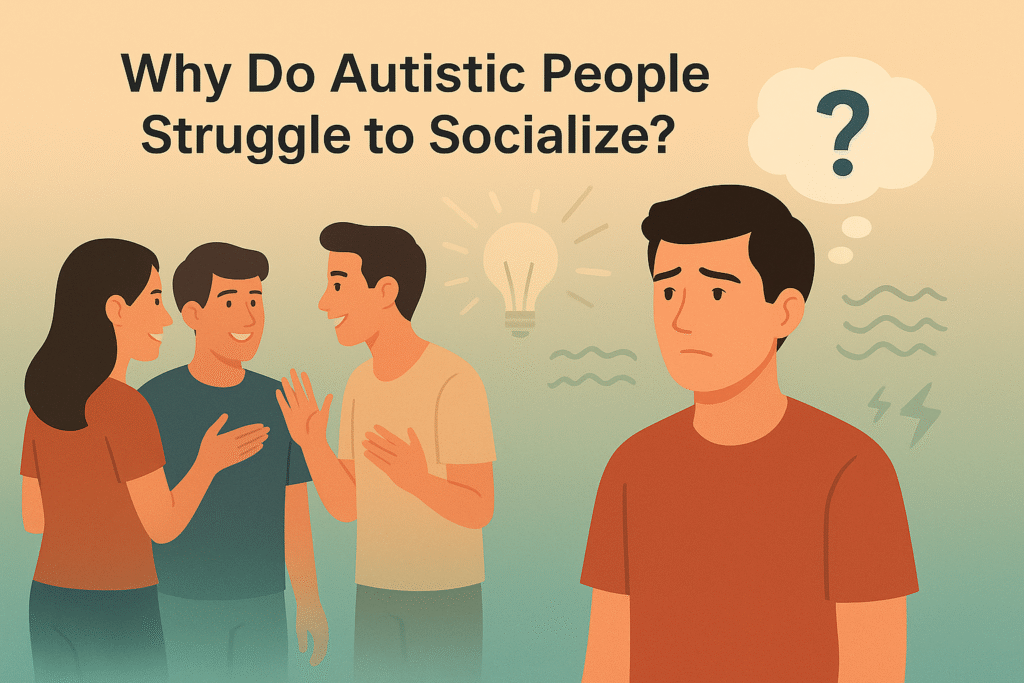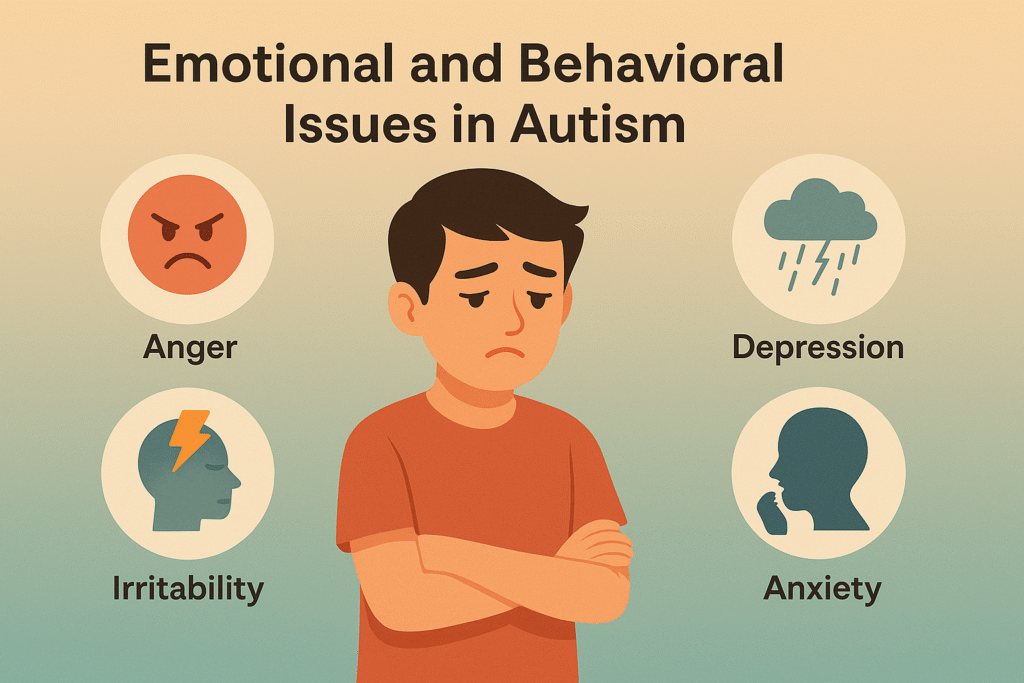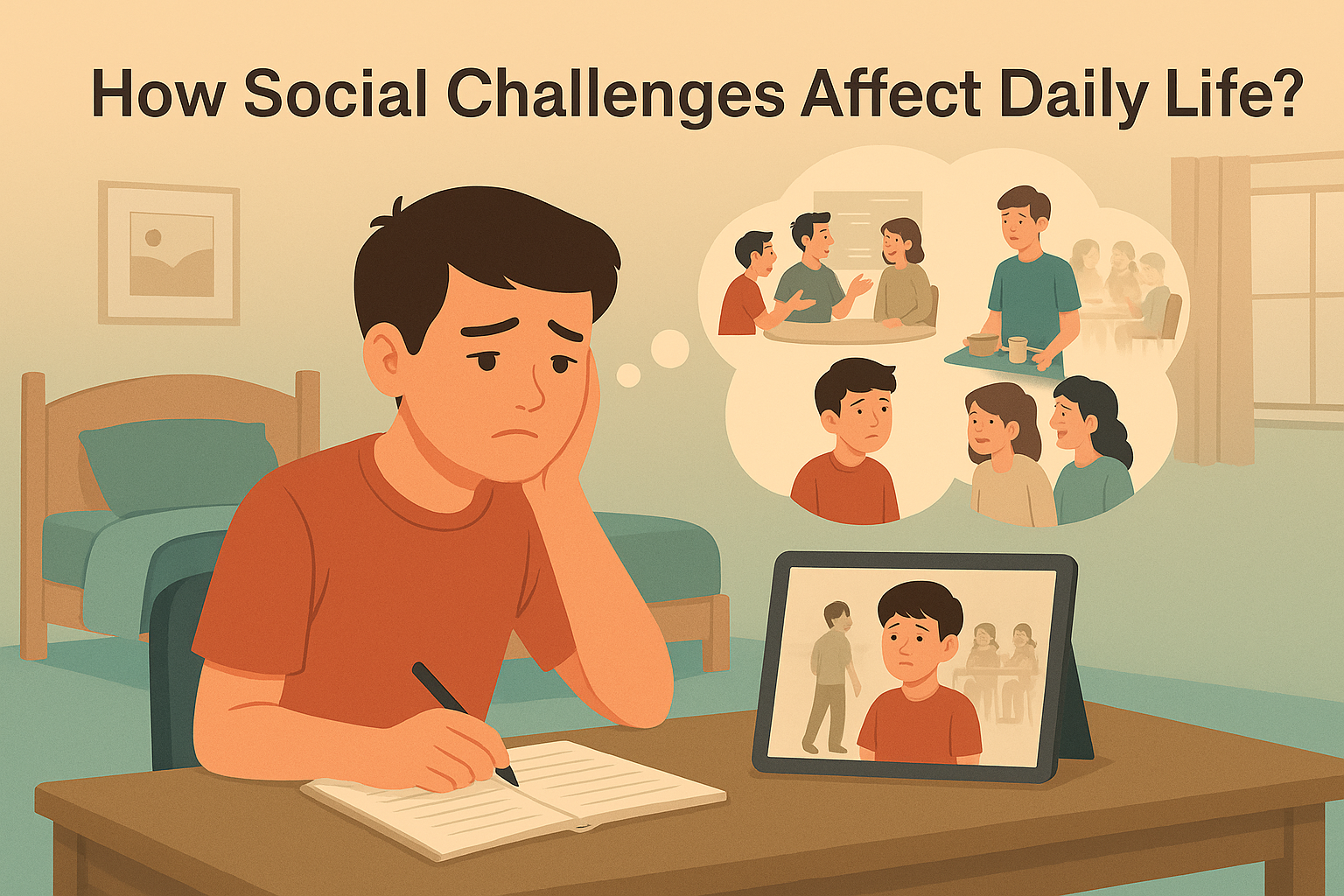Have you noticed how your child can solve a puzzle meant for adults but freeze when asked to join a group game?
That’s where social challenges in autism start to show up. It’s not that your child doesn’t want to talk or make friends, but their understanding of people can sometimes feel tricky.
It is not easy for them to read facial expressions, tone, or body language, and they can feel like they are trying to follow a conversation in a language they don’t fully understand.
These struggles can make them feel left out or anxious. Instead of panicking, you need to handle these situations with patience, empathy, and the right kind of support. Once your approach to handling these situations changes, they can learn to connect beautifully.
Let’s understand why these challenges happen and what parents can do to make social situations a little easier for their child.
Social Challenges in Autism
Social challenges in autism are more than what you see and experience with your child. Here, you need to understand that autism affects how a person understands and responds to social cues like facial expression, body language, tone of voice, or pitch of voice.
That is why they find it hard to understand everyday conversation. For the same reason, it is not easy for them to join a conversation, make friends, and understand jokes. All these are confusing or overwhelming for them.
It doesn’t mean they lack interest in joining a conversation. Rather, this happens because social communication doesn’t come naturally to many autistic children and adults.
Why Do Autistic People Struggle to Socialize?

Autistic people find it hard to socialize because their brains process information differently. They have neurological and sensory differences that affect how they figure out and respond to social communication.
Let us help you understand with an example. It is difficult for children with autism to understand nonverbal cues like facial expressions and tone of voice instinctively. It may be natural for you, but not for them. They need to put in conscious efforts to understand them.
Also, many autistic people find eye contact uncomfortable and struggle with social reciprocity. Social reciprocity means the give-and-take nature of social interactions, where people respond to one another’s actions with similar or equivalent responses. For example, they fail to understand when to speak, listen, or show interest.
Additionally, children with autism face sensory overload, and they have problems with bright lights, background noise, or too many conversations happening at once. They create anxiety and make it hard to focus on social interaction.
Their neurological wiring, social anxiety, and sensory sensitivity make social interactions stressful instead of enjoyable.
Types of Social Interaction Difficulties in Autism
It is confusing and draining for an autistic person to socialize. They don’t want to avoid people, but they have to undergo many daily communication hurdles, which you or other neurotypical people may take for granted.
These challenges the child faces can show up in many ways, like how they read or how they express themselves.
Let’s learn about them:
Communication Challenges
Verbal and Nonverbal Communication Differences
Social Understanding and Empathy
Social Connection and Group Activities
Routines and Repetitive Behaviours
Intense Interests
Emotional and Behavioural Issues in Autism

So far, you have learned about how social challenges affect your child’s communication skills. But they shape how they feel about themselves and the world around them. These difficulties can impact their minds negatively and create emotional and behavioural issues.
It happens when they’re constantly trying to fit into social situations that don’t feel natural or predictable to them.
1. Feelings of Loneliness or Frustration
Your child may want to connect with others but struggles to express themselves or understand others. This naturally leads to frustration.
Your child may deal with moments where they feel left out or misunderstood. Simple interactions can be exhausting for them, and this makes them feel lonely, especially when they notice social gaps that others don’t have to think about.
2. Bullying and Its Emotional Toll
Bullying in autism is unfortunately common. Your child’s differences in communication, body language, or interests sometimes make them easy targets of bullies.
Being teased, excluded, or mocked for these differences can deeply affect their confidence. This impacts their self-esteem and can make them feel unsafe or anxious in social environments.
3. Social Anxiety and Avoidance
As your child faces social situations repeatedly that are confusing or painful, it’s natural for social anxiety to develop. The child may begin to worry about saying the wrong thing, misreading cues, or being judged.
This may lead to withdrawal, skipping group activities, avoiding conversations, or choosing solitude over interaction, and this happens because they’re trying to protect their emotional well-being, not because they don’t care.
These emotional challenges are not created by autism. They are caused by constant pressure to fit into a communication system that is different from theirs.
So when, as a caregiver or a parent, you understand these emotional burdens and support them with acceptance and care, you help your child feel more confident and connected.
How Social Challenges Affect Daily Life?

Your child’s social difficulties don’t stay limited to conversations. These issues influence their many everyday experiences. These challenges can shape how they learn, work, and form relationships. They may make everyday situations feel more complicated than they appear.
1. Group Participation and Classroom Dynamics
Your child may face issues in school performing activities that require group discussions, quick responses, or teamwork. They may hesitate to speak up, struggle to keep up with fast-moving conversations, or feel unsure about when to join in.
Noisy classrooms, unexpected changes, unclear instructions, or sensory distractions like bright lights or too much movement can add to their stress. This makes learning environments more difficult to adapt to.
2. Challenges in Teamwork or Friendships
Friendships and teamwork rely mostly on understanding social cues, like when someone is joking or how to respond in social moments. But it may be different for your child, as these signals don’t always come naturally to them, and they may find it difficult to build or maintain friendships.
Group projects or social activities might feel confusing or exhausting for them, which can lead to misunderstandings or a sense of being left out.
3. Difficulties in Understanding Workplace Cues
Workplaces are full of indirect communication and unspoken rules, which can be difficult for an autistic adult. Things like reading tone, knowing when to join a conversation, or understanding casual office humor can be challenging for them.
Sudden changes in routine or unclear expectations may also create stress in their mind. They may excel in focused but structured roles, but dealing with workplace social cues can make daily tasks feel more demanding.
Building Social Skills and Confidence

You need to support your child. But never try to “fix” them. Instead, you can give them tools, comfort, and confidence so social situations feel less confusing and more manageable. With the right guidance, these skills can grow over time in a way that feels natural and stress-free.
1. Social Skills Training and Role-Playing
Structured social skills training is one of the most helpful ways to address social skills deficits in autism. Role-playing everyday situations, like starting a conversation, taking turns, or understanding tone, gives them a safe space to practice without pressure. Breaking social tasks into small, clear steps helps build confidence and makes interactions feel more predictable.
2. Speech and Occupational Therapy
Speech therapists can help with everything from improving conversation skills to understanding sarcasm or emotions in speech. Occupational therapists often work on nonverbal skills, sensory challenges, and everyday routines that make social situations easier. These therapies together help strengthen communication, self-expression, and emotional regulation.
3. Support from Parents and Teachers
A calm, patient, and empathetic approach at home and school makes a huge difference. Parents and teachers can help by:
- Giving clear, simple instructions
- Preparing the child for changes in routine
- Modeling social behavior
- Gently guiding them through unfamiliar situations
Creating an understanding environment removes pressure and helps autistic individuals feel safe enough to try new social skills.
Support Systems and Hope for the Future

Strong support systems make a huge difference in helping autistic individuals navigate social challenges. Family and peer support groups offer understanding and a safe space to share experiences, reducing the feeling of facing everything alone.
Creating inclusive environments at school, work, and in the community helps autistic people feel accepted instead of judged for their differences. At the same time, new therapies and approaches are constantly emerging to improve social communication in autism, giving families more hope and tools for the future.
With awareness, compassion, and the right support, the biggest challenges for people with autism become far more manageable, helping both children and high-functioning autistic adults feel more confident and understood.
Takeaway

With early understanding, patience, and the right support systems, social challenges in autism don’t have to hold anyone back.
Compassion from families, teachers, and communities, paired with helpful therapies and consistent guidance, can make communication and relationships feel far more manageable. Over time, autistic individuals can build confidence, strengthen social skills, and enjoy more meaningful connections in everyday life.
Frequently Asked Questions (FAQs):
Q1. Does autism limit daily activities?
A. It can, but the level varies for each person. Tasks like group work, navigating noisy spaces, understanding workplace cues, or handling unexpected changes can be harder because of autism social interaction difficulties.
Q2. What are the emotional challenges of autism in social settings?
A. Feelings of frustration, loneliness, or being misunderstood are common. Bullying in autism can worsen emotional stress, and many individuals deal with social anxiety that leads to avoiding certain people or places.
Q3. How does a high-functioning autistic person act socially?
A. A high-functioning autistic person might appear very capable in many areas but still struggle with things like sarcasm, small talk, or reading tone. They may come across as direct or overly honest, or prefer deeper conversations over casual chit-chat.
Q4. What is the biggest challenge for people with autism in social communication?
A. Understanding unspoken social rules is often the toughest. From knowing when to jump into a conversation to recognizing someone’s mood, these invisible expectations can create confusion and stress.
Q5. How does autism affect a person’s daily life socially?
A. Social situations at school, work, or home may require extra effort. Making friends, interpreting instructions, or adjusting to changes can be draining, and these struggles sometimes lead to social isolation in autism.
Q6. Why do some autistic individuals prefer being alone?
A. It’s usually not about disliking people. Many choose solitude because it feels calming and predictable, especially when social communication in autism takes a lot of energy.
Q7. How can families support social communication development?
A. Families can help by practicing simple conversations, using role-play, encouraging special interests during social activities, and being patient with nonverbal cues. A calm, predictable environment helps build confidence at home.
Q8. What is the most common problem with autism?
A. Difficulties with social communication and interaction, and restricted or repetitive behaviours and interests are some of the common problems of autism.
References
Relevant Articles For You
Infantile Autism
Infantile autism refers to autism in young children whose age is approximately 2 years. Autism spectrum disorder on…..Read More
Is Autism Curable?
Autism is not a disease, so it cannot be “cured” in the traditional sense. It is a lifelong neurodevelopmental…..Read More
Prevalence and Incidence of Autism
Autism Spectrum Disorder (ASD) is a neurodevelopmental condition characterized by difficulties in social…..Read More
Recommendations To Understand Different Treatments
Autism
ASD (Autism Spectrum Disorder) is a condition that affects how people communicate and interact with others. It can also involve…..Read More
Autism Treatment Options
When it comes to treating autism, there’s a whole range of options out there, from your standard treatments to procedures like…..Read More
Stem Cell Therapy For Autism
Stem cell therapy uses your body’s regenerative power. These cells can transform into specialized cells and repair…..Read More
Combination Therapy For Autism
Every child is different. That’s why we don’t believe in “one-size-fits-all” solutions. Instead, we combine advanced therapies with…..Read More
Homeopathy For Autism
Homeopathy is a 200-year-old science that focuses on holistic healing. Its goal is to balance the mind and body. It improves the…..Read More
Ayurveda For Autism
The treatment plan will be decided based on the diagnosis. The doctor may choose a combination of internal or…..Read More
Medically Reviewed by MedicoExperts Editorial & Clinical Review Board on 18 November 2025
Medical Disclaimer: This content is for informational purposes only and is not intended as medical advice, diagnosis, or treatment. Always seek the advice of your physician or other qualified healthcare provider regarding any medical condition or dietary needs.




